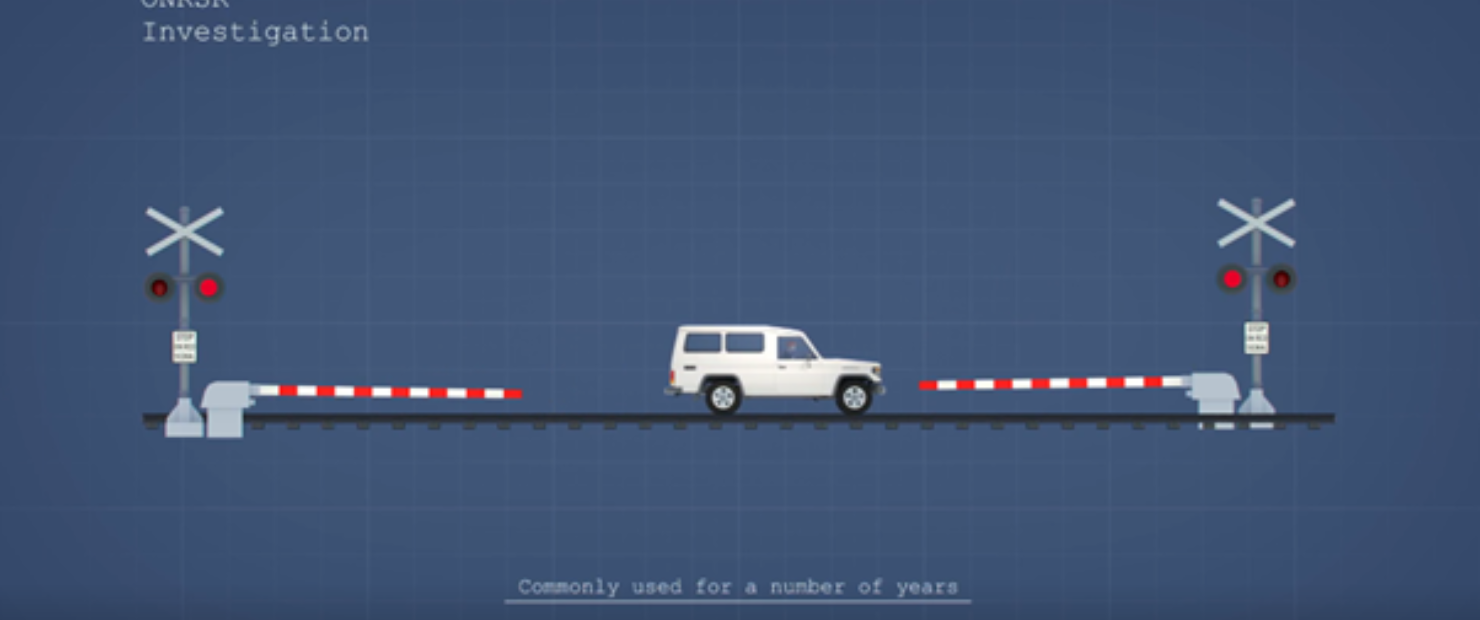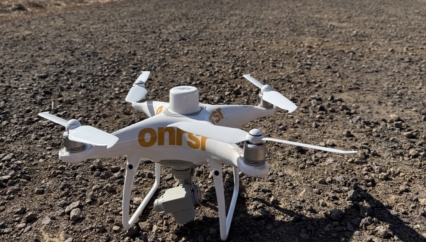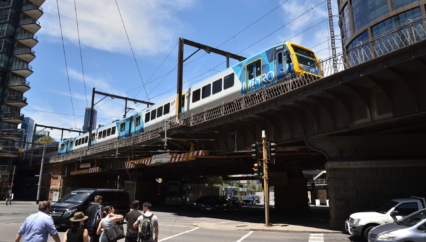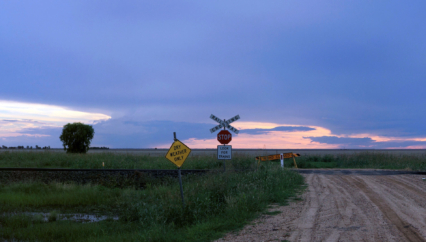Keep up with all ONRSR's news and information to the rail industry - current and earlier items located here.

Safety message: digital recreation #9 - Hazard Risk Analysis SFAIRP
Safety message: digital recreation #9 - Hazard Risk Analysis SFAIRP

Stakeholder Forums Off and Running
ONRSR’s renewed focus on engagement and communication with operators and safety stakeholders is in full swing with a series of tourist and heritage forums being held across the country.

ONRSR Top Guns In Demand
ONRSR’s National Investigations team has showcased its industry leading aerial intelligence capability after being called upon to demonstrate the infield effectiveness of its innovative Remotely Piloted Aircraft System (RPAS) – more commonly known as the ONRSR drone.

ONRSR 2024-2025 Corporate Plan released
The ONRSR Corporate Plan 2024-2025 has been published today. The plan sits alongside ONRSR’s Strategic Directions 2024-2027 and demonstrates our commitment to enhanced risk-based regulation, sharing of information and insights, and collaboration with industry.

Level Crossings and Train Visibility – the New Code of Practice Explained
ONRSR has released the first Code of Practice covering level crossings and train visibility – so what does it mean for rail transport operators specifically and for a host of rail safety stakeholders including members of the public?
Australian First LX Code of Practice Released
The Office of the National Rail Safety Regulator (ONRSR) has released an Australian-first Code of Practice designed to improve safety at thousands of level crossings around the country.
ONRSR Portal Refresh Webinar recording
ONRSR recently conducted a series of webinars, following a refresh of the back-end technology which supports the ONRSR Operator Portal. These webinars offered attendees the opportunity to view and understand the enhancements released as part of the Operator Portal update.
Full Application of RSNL Live in WA – 1 October
Following its passage through the Western Australian Parliament earlier this year and a comprehensive period of stakeholder engagement, the full application of Rail Safety National Law (RSNL) will commence in WA from 1 October 2024.
Second Train Visibility Research Report Released
The Office of the National Rail Safety Regulator (ONRSR) has today released a second independent assessment of the effects of additional lighting on freight locomotives.
ONRSR on iTRACE and the Role of Harmonisation
Each year, ONRSR’s annual Rail Safety Report provides a comprehensive statistical analysis of the Australian rail industry. Among the many data sets included in the report are some that relate to equipment malfunctions or infrastructure failure.
It’s Rail Safety Week – ONRSR Spreading the Message
ONRSR has once again thrown its support behind TrackSAFE Foundation’s annual Rail Safety Week 5-11 August and will continue to use its own platforms and networks to help remind all Australians of how they can stay #railsafe.
Opinion: Crossing to the Same Side
Simple mistakes are often to blame for incidents at Australian level crossings but stopping them is a complex problem.
24/25 Fee Reg – Overview
As another financial year comes to a close, ONRSR is outlining to all accredited operators, and our wider stakeholder community, the details of changes to its annual fees for 2024-2025.
ONRSR welcomes outcome of national law review
ONRSR has welcomed the release of the National Transport Commission’s final report on its targeted review of the Rail Safety National Law.
ONRSR Boosts Strategic Focus of Drug and Alcohol Testing
The national regulator will use improvements in the quality of rail safety data to re-focus its drug and alcohol testing regime, ensuring a more evidence-based approach to testing.
Review and update to Rail Locomotive Boilers Guideline
The ONRSR Rail Locomotive Boilers Guideline provides rail transport operators with guidance on ONRSR’s expectations for demonstrating the safety of rail locomotive boilers. It also includes some guidance on the operation of reciprocating steam engines.
NLXP Consultation Feedback
At ONRSR we are always looking for ways to improve and support safety. The National Level Crossing Portal (NLXP) was originally developed to provide better information to support operators in their safety management decisions at level crossings.
Safety Alert - Direct Drive Hydraulic Pumps
The Office of the National Rail Safety Regulator (ONRSR) has issued a new Safety Alert advising rail transport operators of the risk of uncontrolled movements associated with direct drive hydraulic pumps installed on Road Rail Vehicles (RRVs).
ONRSR Welcomes Passage of RSNL in WA
The Office of the National Rail Safety Regulator (ONRSR) has welcomed the Western Australian Parliament’s decision to approve the full application of Rail Safety National Law (RSNL).
ONRSR Statement On Wallan Findings
The Australian Rail Track Corporation (ARTC) and NSW Trains have been found guilty of breaches of Rail Safety National Law in relation to the derailment of a passenger train that killed two rail safety workers at Wallan, Victoria in February 2020.
ONRSR Welcomes RSNL Court Clarification
ONRSR has welcomed the outcome of an appeal in the NSW Supreme Court by rail transport operator, Aurizon, against a decision that saw a variation to its accreditation denied on the basis of inadequate consultation with rail safety workers.
National Rail Safety Data Strategy delivers significant safety data improvements
A joint initiative of the Office of the National Rail Safety Regulator (ONRSR) and the Australasian Railway Association (ARA) to undertake a massive overhaul of industry rail safety data reporting has now been completed, marking a significant milestone for the Australian rail industry.
Safety Alert follow up - ASQA
Following the release of an ONRSR safety alert the Australian Skills Quality Authority is now investigating technical training providers who are registered training organisations delivering rail worker industry competencies.
ONRSR Statement - Fatal Accident 31.12.2023
The Office of the National Rail Safety Regulator has deployed investigators to the scene of today's fatal accident near the South Australian and NSW border.
Safety Alert - Incidents involving Manco rail equipment
Safety Alert - Safeworking Competencies Compromised
ONRSR facilitates demo of clean, green auto wagon
ONRSR was recently on site when Arc Infrastructure publicly revealed its Autonomous Rail Wagon (ARW) concept with a demonstration of the rolling stock’s capabilities at the Kenwick Rail Freight Facility in Perth.
Queensland Rail fined over 2021 fatal accident
ONRSR will use a court ruling into a fatal train accident to continue educating rail transport operators of the risks associated with long end leading locomotive operations and actions required to improve safety.
ONRSR welcomes new Chief Executive
The search for Australia’s next National Rail Safety Regulator is over, with Dr. Natalie Pelham appointed Chief Executive of the Office of the National Rail Safety Regulator.
Train driver fined $5,000 for disregarding legal notice
The Office of the National Rail Safety Regulator (ONRSR) has welcomed a decision in the Brisbane Magistrate’s Court to fine a train driver for failing to attend a post-incident interview.
$20,000 fine for train driver
A Victorian train driver who exposed his passengers, and those on another train, to the risk of a catastrophic collision while talking on his mobile phone has been fined $20,000 in the Melbourne Magistrate’s Court.
ONRSR backing Rail Safety Week '23
ONRSR is again throwing its support behind the upcoming Rail Safety Week (August 7-13), using the important period to highlight the responsibility we all have for safety on the network.
Repeat Offender Cops Fatigue Conviction
The Office of the National Rail Safety Regulator (ONRSR) has welcomed the finalisation of proceedings against a rail safety worker in New South Wales who pleaded guilty to three charges relating to serious and repeated breaches of Rail Safety National Law (RSNL)
New ONRSR Fact Sheet Released: Powers to Obtain Information
ONRSR has released a new rail industry fact sheet designed to clarify the requirements when persons, particularly rail safety workers, are compelled to answer questions by our Rail Safety Officers.
Driver charged over potentially deadly breach
The Office of the National Rail Safety Regulator (ONRSR) has this week charged a Victorian train driver who it alleges exposed numerous passengers and crew to the risk of death or serious injury by recklessly passing through multiple red signals while talking on a mobile phone.
National Law boosted to stamp out competency frauds
Rail safety workers using fraudulent qualifications will face fines of up to $10,000 under changes being made to Australia’s Rail Safety National Law.
Queensland Rail charged over fatal accident
The Office of the National Rail Safety Regulator (ONRSR) has filed three charges against Queensland Rail (QR) following an investigation into a fatal train accident at Westwood, near Rockhampton in Queensland, in June 2021.
ONRSR welcomes conviction on rail safety worker failure
ONRSR has welcomed a conviction, under Rail Safety National Law, recorded against a rail safety worker whose actions endangered others at a Queensland worksite in 2020.
Safety Forum shines light on Illawarra Range
ONRSR has hosted representatives of some of the largest rail transport operators in Australia at a forum dedicated to optimising safety in one of the nation’s busiest rail corridors.
Investigations @ ONRSR - a visual guide
Our safety animations are a very effective and popular way to provide information to operators and individuals alike. This time we have tweaked the format a little.
Level Crossing Isolation - Safety Video
New safety video produced by ONRSR on safety measures around level crossing isolation.
ONRSR Prosecution: Warning to all in Magistrate’s decision
A train driver who put lives at risk after inexplicably “losing” four carriages and failing to take immediate action to secure and recover them has been issued a $30,000 fine for two breaches of Australia’s Rail Safety National Law (RSNL).
Safety Alert - Independent Competent Persons (ICPs) that certify rolling stock
Sue McCarrey to depart national rail regulator
Following a highly successful eight-year tenure spent fostering Australia’s fledgling rail regulator into a nationally recognised safety authority, ONRSR Chief Executive Sue McCarrey will depart her post at the end of the year.
Decisions, Delivery and Data - A decade of ONRSR
On the 20th of January 2013 the Curiosity Rover found signs that water once flowed on Mars. Elsewhere, Barack Obama was sworn in for a second term as President of the United States, and a little closer to home, a heat wave that had sparked bushfires across much of south-eastern Australia finally relented.
And on that same day, in a somewhat less seismic but nonetheless historic development, the doors opened at the Office of the National Rail Safety Regulator.
Notice to all operators - Cyber security alert
The Office of the National Rail Safety Regulator (ONRSR) has become aware of an accredited rail transport operator (RTO) receiving an email requesting payment of its Annual Fees Invoice to updated banking details. The email comes from an account purporting to be ONRSR.
Girl power @ ONRSR
Like the broader Australian rail industry, ONRSR has worked hard since its inception to provide career pathways for women into what were once male dominated roles.
ONRSR welcomes operator incident recreation
For the past 2 years, ONRSR has been using digital re-creations of rail safety occurrences as an educational tool for rail transport operators. Recently, some rail transport operators have begun developing their own digital animations that detail the circumstances of incidents that have occurred.
ONRSR welcomes focus of Rail Safety Week '22
Australia’s National Rail Safety Regulator has thrown its support behind Rail Safety Week 2022 and its emphasis on the dangers of distraction.
Safety Alert RSA-2022-001 Infrastructure Trailers: Coupling and Braking Systems
The Office of the National Rail Safety Regulator (ONRSR) has today issued a new Safety Alert advising rail transport operators of the risk of unbraked runaway associated with coupling systems and braking systems fitted to infrastructure trolleys and trailers.
National Rail Safety Data Strategy – Go Live – 1 July 2022
The Office of the National Rail Safety Regulator (ONRSR) and the Australasian Railway Association (ARA) are today celebrating a major milestone following the official launch of Australia’s new rail safety data reporting scheme.
ONRSR prosecutes on synthetic urine sample
ONRSR has commenced its first prosecution against a rail safety worker for attempting to provide synthetic urine when directed to provide a sample for routine drug and alcohol testing.
Updated NSW Rail Safety Regulation
The NSW Rail Safety (Adoption of National Law) Regulation 2018 is being amended.
National Priorities review
Every two years ONRSR reviews its national priorities, those areas of regulatory focus that apply to multiple jurisdictions and operators and warrant a sustained period of regulatory attention.
In-Cab audio & video endorsed
In late 2021, Federal and State Transport Ministers endorsed ONRSR’s policy to mandate in-cab audio and video on mainline passenger and freight trains.
Train Visibility Review
A review of research, and national and international best practice in relation to train visibility – commissioned by the Office of the National Rail Safety Regulator (ONRSR) has been completed.
ONRSR 2020-2021 Rail Safety Report
Safety Alert - Fraudulent Rail Safety Worker competencies
The Office of the National Rail Safety Regulator (ONRSR) has today issued a new Safety Alert advising rail transport operators that a check and verification process has revealed that a significant number of fraudulent competencies have been uploaded into the Rail Industry Worker (RIW) program.
Welcome to a new www.onrsr.com.au
All rail safety stakeholders across Australia are welcomed to ONRSR’s brand new website.
UPDATE: Identifying Rail Safety Work under the RSNL Guideline
ONRSR has updated the Identifying Rail Safety Work under the RSNL Guideline which provides guidance on the term “rail safety work”, and outlines how rail transport operators (RTO) can identify rail safety workers as part of their risk management processes.
New smart resource a game changer for level crossing safety
A brand new digital resource for the rail industry is set to transform the management of safety at more than 20,000 level crossings around Australia.
Regulator using Rail Safety Week to highlight priority issues
ONRSR has thrown its weight behind TrackSafe’s Stand Back, Look Up, Stay Rail Safe, campaign, while also using this Rail Safety Week to highlight how its focus on a series of national rail safety priorities is helping keep Australians safe on the rail network.
Contractor management update - July 2021
The contractor management national priority has been scoped to include a 4-phase approach
Safety Alert issued: Review of long end leading operations
ONRSR has today issued a new Safety Alert advising rail transport operators to review the risks associated with ‘long end leading’ locomotive operations.
ONRSR Engauge-ment Forum #1
In early June, ONRSR held the first of its new Engauge-ment Forums, meeting with representatives from accredited operators located in the Pilbara region of Western Australia. Previously badged as Branch Operations Forums (or BOFs), these face-to-face sessions are a great opportunity for industry representatives to get information most relevant to them.
Best practice Track Worker Safety resource released
ONRSR, in conjunction with the Rail Industry Safety and Standards Board (RISSB), has released the results of a global investigation into how world standard technology can protect track workers in the Australian rail industry.
Consultation paper - National Rail Safety Data Strategy
The National Rail Safety Data Strategy (the Strategy) is a joint project between the Office of the National Rail Safety Regulator (ONRSR) and the Australasian Railway Association (ARA). The proposed data set has been developed jointly by ARA, ONRSR and industry representatives.
New Control Assurance Fact Sheet
ONRSR has produced a new industry fact sheet covering its National Priority rail safety issue of control assurance.
Safety Alert issued: Isolation of level crossings on adjacent lines
ONRSR has issued a Safety Alert in response to several recent occurrences where level crossings were incorrectly isolated resulting in trains travelling through unprotected level crossings.
Network Control Safety Issues
ONRSR is providing more information to rail transport operators and network controllers about the common issues we have identified across network control operations in Australia.
ONRSR Rail Safety Report 2019-2020
ONRSR’s yearly account of rail safety has been released and as the first such report produced since becoming a fully national rail safety regulator, it provides the most comprehensive statistical picture of the Australian rail industry’s safety performance to date.
Investigations at ONRSR
ONRSR’s ability to take a detailed and formal look at the circumstances behind a specific rail safety issue is a fundamental element of our broader role in administering Rail Safety National Law. But, exactly how does the national regulator approach investigations?
ONRSR Guideline - Fatigue Risk Management
ONRSR has developed a Fatigue Risk Management Guideline to provide practical guidance to rail transport operators on how to manage the fatigue-related risks associated with rail safety work and set out ONRSR’s expectations for meeting the requirements of the RSNL.
ONRSR releases 2019-2020 Annual Report
ONRSR’s Annual Report 2019–2020 is now available to download.
National Rail Safety Data Strategy Consultation
ONRSR has partnered with the ARA and industry representatives to develop the National Rail Safety Data Strategy with the aim to deliver a relevant, consistent and high-quality national rail safety dataset that is readily available to stakeholders to make rail safety decisions.
In-cab audio and video safety recordings: Consultation Regulatory Impact Statement
It is timely to consider the value of in-cab video and audio recordings in providing critical information about the in-cab environment in the moments leading to a rail incident on Australia’s rail network. This has been highlighted following recent fatal rail incidents and also in response to a number of ATSB investigations, where this information would help provide investigators and the rail industry with critical information that may help to prevent a similar incident from occurring again.
ONRSR Major Projects Guideline review and update
The ONRSR Major Projects Guideline is one of the most accessed of our industry resources and given the significant investments being made in major rail projects around Australia, it is more important than ever.
Consultations to round out 2020
ONRSR will be using the closing months of 2020 to undertake stakeholder consultation on a range of key policy matters affecting the Australian rail industry.
Draft Fatigue Risk Management Guideline for consultation
ONRSR has produced a draft Fatigue Risk Management Guideline to provide practical guidance to rail transport operators on how to manage the fatigue-related risks associated with rail safety work and set out ONRSR’s expectations for meeting the requirements of the RSNL.
New fact sheets - Safe software and safe systems
ONRSR has developed two new fact sheets for industry to help ensure system upgrades – be they physical or digital - are implemented as seamlessly and safely as possible.
Reminder: Immediate incident notification
ONRSR is reminding operators of the requirement to verbally report Category A incidents immediately – also noting where two operators are involved, both operators must notify ONRSR.
Identifying rail safety work – changes from 1 July 2020
Changes to the definitions of rail safety work in the Rail Safety National Law will take effect from 1 July 2020 (except in Western Australia). This follows the work of the National Transport Commission and agreement of State and Territory Ministers in November 2019.
New Fact Sheet released for Tourist & Heritage operators
With the gradual reopening of services and operations, ONRSR has prepared a Fact Sheet providing Tourist & Heritage operators with relevant information to assist them in complying with all requirements of their safety management system (SMS) after an extended shutdown of operations.
Collaboration to ID best practice safety for Aussie rail workers
Australia’s leading authorities on rail safety will join forces to identify world standard safety technology that can be deployed to protect workers on our nation’s rail networks.
Website updates and document withdrawal
The ONRSR website has undergone some recent changes; including content updates of existing material and the introduction of new pages.
New SMS modules for T&H and smaller operators
In response to feedback from Tourist and Heritage operators and, as part of broader stakeholder engagement, ONRSR has been working with the sector to roll out a number of initiatives to support the Tourist and Heritage sector and other smaller less-complex operators.
Stakeholder Survey Generates Invaluable Insights
On a daily basis ONRSR engages with a multitude of rail safety stakeholders in carrying out its functions and pursuing its objectives under Rail Safety National Law.
ONRSR calls for independent track audit
The Office of the National Rail Safety Regulator (ONRSR) has called on the Australian Rail Track Corporation (ARTC) to immediately commission a fully independent audit of the railway track between Sydney and Melbourne.
ONRSR Chief hails the decade of delivery
ONRSR Chief Executive and National Rail Safety Regulator, Sue McCarrey has reflected on the past decade confident it will be remembered as one of the most telling periods ever for safety and efficiency in the Australian rail sector.
ONRSR Welcomes Productivity Commission Draft Report
The Office of the National Rail Safety Regulator (ONRSR) will continue its pursuit of safe railways for Australia, buoyed by the key findings of the Productivity Commission’s Draft Report into National Transport Regulatory Reform.
ONRSR formalises jurisdiction in Victoria
Responsibility for rail safety regulation in Victoria will officially transfer from Transport Safety Victoria (TSV) to the Office of the National Rail Safety Regulator (ONRSR) from December 2.
Changes to the NSW drug and alcohol identity card issuing process
Following consultation with NSW rail transport operators (RTOs) and third party testing service providers, ONRSR is introducing changes to the NSW drug and alcohol identity card issuing process.
Release of NTC Dangerous Goods Emergency Response Guide
If you transport dangerous goods by rail, then the following article may be of interest to you.
Introduction of Prescribed Incidents on 1 July 2019
UPDATE: Please see updated information by following this link.